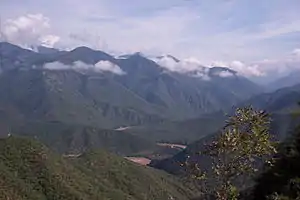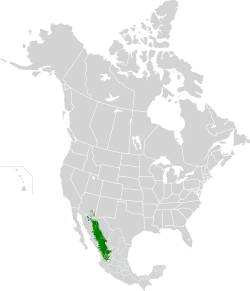Sierra Madre Occidental pine–oak forests
The Sierra Madre Occidental pine–oak forests (Spanish: Bosques de pino-roble de la Sierra Madre Occidental) are a subtropical coniferous forest ecoregion of the Sierra Madre Occidental range from the southwest USA region to the western part of Mexico. They are home to a large number of endemic plants and important habitat for wildlife.
| Sierra Madre Occidental pine–oak forests | |
|---|---|
 | |
 Sierra Madre Occidental pine–oak forests | |
| Ecology | |
| Realm | Nearctic |
| Biome | Tropical and subtropical coniferous forests |
| Borders | |
| Bird species | 319[1] |
| Mammal species | 164[1] |
| Geography | |
| Area | 222,700 km2 (86,000 sq mi) |
| Countries | United States and Mexico |
| States | Arizona, New Mexico, Sonora, Chihuahua, Durango, Zacatecas and Jalisco |
| Conservation | |
| Global 200 | Yes |
| Habitat loss | 5.3745%[1] |
| Protected | 6.2%[1] |
Setting
The Sierra Madre Occidental run north to south in western Mexico from the center of the country towards the United States border. Coordinates of a latitude of N and longitude of W. Where the northern extent of the ecoregion consists of patches of forest on the Madrean Sky Islands sticking up out of the desert of Sonora, Mexico and in the US in Arizona and New Mexico. A Landscape of steep mountain valleys with rivers flowing through the canyons. This is a dramatic landscape of steep mountains cut through with canyons including Copper Canyon, the deepest in North America.
The ecoregion consists of a complex of high elevation pine–oak forest enclaves surrounded at lower elevations by deserts and xeric shrublands and tropical dry forests at lower elevations, including the Sonoran Desert to the northwest, the Chihuahuan Desert to the northeast and east in Arizona, the Meseta Central matorral and Central Mexican matorral to the southeast, and the Sinaloan dry forests to the west and southwest. The Sierra Madre Occidental pine–oak forests are one of the Madrean pine–oak forests ecoregions, which are found throughout the Sierra Madre ranges of Mexico and the US Southwest.
An interesting fact about Mexico and its pine trees is that, this country has more pine species than any other country its size. The Sierra Madre Occidental being the largest mountain range in Mexico, is the home to a huge diversity of pine trees species. There are 24 different pine species in this mountain range and most are located in the highland forests of the Sierra Madre Occidental.
Flora
The original habitats of the Sierra Madre Occidental included forest of pines and Douglas-firs at the higher elevations with oak-wooded grassland on the lower slopes. The vegetation of the pine–oak forest differs between zones of lower temperatures and higher elevations. Some of the Pine trees flourish in higher elevation where more rainfall tends to occur during the summer seasons.[2] The pines and oaks are especially important as there are so many different species of each including a number of endemics. Predominant conifers among the 27 species found here include Apache pine (Pinus engelmannii), Chihuahua pine (Pinus leiophylla), Mexican pinyon (Pinus cembroides), Lumholtz's pine (Pinus lumholtzii), Yécora pine (Pinus yecorensis), Rocky Mountain Douglas-fir (Pseudotsuga menziesii subsp. glauca), and Mexican Douglas-fir (Pseudotsuga lindleyana).
Oaks (Quercus) are the dominant broadleaf trees, with 21 different species found including Quercus albocincta, Arizona oak (Q. arizonica) Q. carmenensis, Q. chihuahuensis, Q. cordifolia, Q. durifolia, Emory oak (Q. emoryi), Q. grisea, Mexican blue oak (Q. oblongifolia), Q. santaclarensis, and Q. tarahumara. Madroño (Arbutus xalapensis and A. arizonica) is found in association with oaks. Q. carmenensis and Q. deliquescens are two oaks endemic to the sky islands portion of the ecoregion.
Fauna
The forests are home to more than 300 species of birds including golden eagle, thick-billed parrot (which is now endangered having been trapped for collections), military macaw and tufted jay, and were once home to the imperial woodpecker which is now thought to be extinct.
Mammals include the Coues deer, American black bear and jaguar. The rare Mexican wolf was once common in the mountains but is now not found in the wild while the Mexican grizzly bear is now thought to be extinct.
The many reptiles include the rock rattlesnake (Crotalus lepidus), twin-spotted rattlesnake (Crotalus pricei), ridgenose rattlesnake (Crotalus willardi) and some spiny lizards (Sceloporus clarki, S. jarrovi, S. scalaris and S. virgatus).
Finally, the mountains are an important stage in the migration route of monarch butterflies.
Conservation and threats
The pine forests have been cleared by the logging and paper industries since the 1800s and only a very small percentage of original forest remains. This removal of habitat has resulted in the presumed extinction of the imperial woodpecker, once the largest woodpecker on earth. Areas prioritised for conservation include Bavispe/Sierra del Tigre and Copper Canyon, while the only protected area is La Michilía. There are a number of protected areas of Madrean sky islands in Arizona which are part of the ecoregion although not the Sierra Madre Occidental themselves, including Chiricahua National Monument, Galiuro Wilderness, the Rincon Mountain district of Saguaro National Park, the Huachuca Mountains, Pusch Ridge Wilderness Area, the Santa Teresa Mountains and the Pajarito Mountains.[3]
The increase of global warming is expected to have some devastating effects on the pine trees located in the Sierra Madre Occidental. The predicted outcome of global warming in this subtropical region, is the reduction of plant/animal productivity and growth. Another effect would be that the increase of climate warming would also lead to tree mortality affecting not only the pine trees located in the Sierra Madre Occidental but also other pine trees in the surrounding areas.
See also
References
- Hoekstra, J. M.; Molnar, J. L.; Jennings, M.; Revenga, C.; Spalding, M. D.; Boucher, T. M.; Robertson, J. C.; Heibel, T. J.; Ellison, K. (2010). Molnar, J. L. (ed.). The Atlas of Global Conservation: Changes, Challenges, and Opportunities to Make a Difference. University of California Press. ISBN 978-0-520-26256-0.
- "Alamos Vegetation". www.desertmuseum.org. Retrieved 2017-05-10.
- "Sierra Madre Occidental pine-oak forests". Terrestrial Ecoregions. World Wildlife Fund. Retrieved 2010-10-10.
3.González-Cásares, Marcos, Marín Pompa-García, and J Camarero. "Differences in Climate-growth Relationship Indicate Diverse Drought Tolerances Among Five Pine Species Coexisting in Northwestern Mexico." Trees: Structure & Function, 31.2 (2017): 531-544.
4. González-Elizondo, Martha, Enrique Jurado, José Návar, M. Socorro González-Elizondo, José Villanueva, Oscar Aguirre, and Javier Jiménez. "Tree-rings and Climate Relationships for Douglas-fir Chronologies from the Sierra Madre Occidental, Mexico: A 1681–2001 Rain Reconstruction." Forest Ecology & Management, 213.1-3 (2005): 39-53.